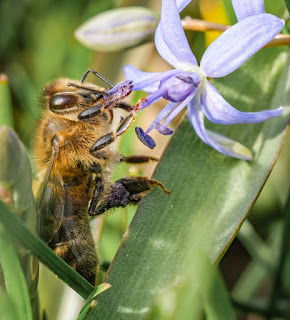Monday, March 1, 2021
Ash Die-Back and Woodland Birds
Saturday, February 27, 2021
Moon Set, Sun Rise
Friday, February 26, 2021
Garden Birds
Wednesday, February 24, 2021
Bees, Ladybirds and Spring Bulbs
Reassuring to see large numbers of Honey Bees at work collecting pollen and nectar from the Anemones, Scilla and Puschkinias. Interesting that the Scilla (fewer stamens) have blue pollen (you can see it on the bee's back leg) while the Puschkinias have the more usual yellow pollen (images 5 and 6). Even one of the Ladybirds had found an aphid to eat.
Tuesday, February 23, 2021
Getting in Close
In 'normal' years, I try to record all the wildlife that I can in our local wood, churchyard and garden during the year. However, with lockdown, this has become more obsessive! I am now starting on the very small creatures that are too small to identify with the naked eye and some are so minute as to require peering at through the microscope. Here we have 4 beetles and a member of the Collembola - a group of Arthropods separate from insects. The first image is using a closeup filter on my macro lens and is a Pollen beetle. The rest are my first attempts at recording with a USB microscope and I did not record the magnification but the beetles are around a 2 mm each.
Saturday, February 20, 2021
Great Year for Snowdrops
Snowdrops are putting on a magnificent display everywhere around us including our village. Here are a few from our churchyard including a ladybird making the most of the warmer weather. Also saw our first Brimstone today though didn't manage a photo. Similar views are using different apertures to see what works best in terms of throwing the background out of focus but keeping the subject sharp.

























































